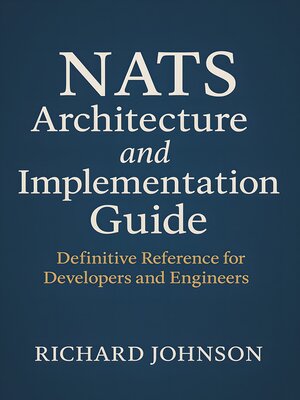NATS Architecture and Implementation Guide
ebook ∣ Definitive Reference for Developers and Engineers
By Richard Johnson

Sign up to save your library
With an OverDrive account, you can save your favorite libraries for at-a-glance information about availability. Find out more about OverDrive accounts.
Find this title in Libby, the library reading app by OverDrive.



Search for a digital library with this title
Title found at these libraries:
| Library Name | Distance |
|---|---|
| Loading... |
"NATS Architecture and Implementation Guide"
The "NATS Architecture and Implementation Guide" offers a comprehensive exploration of NATS, the high-performance messaging system powering modern distributed applications. Beginning with a historical perspective, the book traces the evolution of messaging technologies, highlighting the milestones and paradigm shifts that set the stage for NATS. Readers are introduced to the underlying philosophy of NATS—its emphasis on statelessness, simplicity, and scalability—before examining the system's core components, deployment topologies, supported protocols, and how NATS compares to alternative messaging solutions like RabbitMQ, Kafka, MQTT, and Pulsar.
The guide delves deeply into NATS's core messaging models, communication patterns, and server architecture. It covers publish/subscribe semantics, request/reply mechanisms, queue groups, advanced routing, and consistency guarantees—providing actionable guidance on building high-throughput, low-latency systems. Detailed chapters illuminate the server's internal lifecycle, connection management at massive scale, efficient protocol handling, routing algorithms, concurrency primitives, and robust fault-handling techniques. The book extends this rigor to NATS clustering, global federation, data partitioning, and membership management, offering strategies for resilient, geo-distributed deployment.
A dedicated section focuses on JetStream, NATS's powerful persistence and streaming engine, explaining stream and consumer configurations, durability models, message replay, and resource control. Security-conscious readers benefit from in-depth coverage of authentication, authorization, policy management, and multi-tenancy. The guide also presents best practices for integrating NATS with popular client libraries, microservice frameworks, and cloud-native platforms, alongside advanced operations, diagnostics, observability, disaster recovery, and extensibility for edge, IoT, and hybrid deployments. Concluding with roadmaps, case studies, and best practices, this book is an essential, practical reference for architects, engineers, and DevOps working with NATS at any scale.







